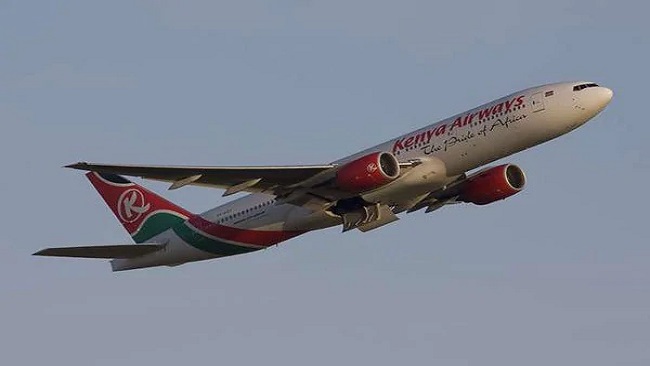Pilot error caused Kenya airways crash that killed 114 people in Douala
A freshly released investigative report has revealed that the May 5, 2007, crash involving a Kenya Airways (KQ) plane in Douala Cameroon was caused by an easy to correct mistake made by the crew at the helm of the routine flight.
The investigation conducted by a joint team of aviation experts from Africa, US and Europe and aired on National Geographic Channel said the pilot and the first officer failed to turn on the autopilot as they climbed to their cruising altitude from Douala International Airport.
Flight507 left the airport at midnight on May 5, 2007 but crashed in a swamp south of the facility after flying for one minute and 30 seconds. All the 114 lives aboard the modern breed of Boeing 737-800 were lost. It was expected to land at Nairobi’s Jomo Kenyatta International Airport (JKIA) on the same day at around 6.15am.
Before the Douala-Nairobi haul, Fligh507 had flown from Abidjan, Ivory Coast and landed at Douala at around 10pm on May 4, 2007. According to the investigation, Flight507 was behind schedule by about an hour due to a big storm that was brewing above the skies of Douala.
After about 20 minutes of waiting, Captain Francis Mbatia, 52, informed the control tower that his onboard weather radar indicated the storm had calmed. He then requested to be granted take off permission. He told traffic controllers that he planned to take a right turn after liftoff to avoid the storm. “Tower…Kenya507, it looks like there is a break in the weather, requesting take off,” said captain Mbatia whose voice was captured by the Cockpit Voice Recorder (CVR).
Air traffic controllers cleared him for take off and directed to use runway 12. Events recreated from the flight show the pilot giving his first officer Andrew Kirui other sets of instructions and the plane later achieved liftoff speed and departed.
Data from the Flight Data Recorder (FDR) shows that despite having planned to fly right of the airport to avoid the storm, Captain Mbatia turned his control column on the left before he released it to allow the autopilot to kick in. This, according to investigators, was supposed to correct some lift problem since the plane had a tendency of generating more lift on the left wing.
Mbatia expected the autopilot to fly the plane using coordinates and headings it was fed with earlier but unknown to him, First Officer Kirui, 23, had not turned it on. UGC Aviation sleuths think the youngster was preoccupied with trying to navigate the plane safely around the heavy storm. “Should I remain on this heading,” Kirui asked Mbatia who gave him an okay he (Kirui) failed to turn the autopilot on. The flight computer would have flown the plane through the preselected flight path. The plane was now being pushed to the limit since it was flying itself at a very dangerous angle.
A few seconds later, Flight507 started banking to the right and the angle kept increasing and later crossed 35 degrees which is considered as critical. Pilots can, however, recover from it by allowing the autopilot to fix it as long as they still have the advantage of altitude. For the case of Flight507, the plane was flying with its left wing pointing almost directly to the sky at 90 degrees and the right wing nearly pointing directly to the ground.
UGC Investigators say when the crew realised all was not well, Captain Mbatia erratically performed manoeuvres on the control column to try and fix the situation. At this time, the plane was flying about 2,400 feet above the ground. Mbatia, however, learnt that the plane was not responding to his inputs. He quickly figured out that the autopilot was off and swiftly turned it on to enable the plane to recover from the critical angle it was flying. What, nevertheless, puzzles investigators is that instead of Captain Mbatia allowing the autopilot to kick in, he started fighting with the control column again with more erratic movements. He overrode the autopilot since he felt it had taken long before correcting the dangerous bank to the right. This allowed the brand new Boeing 737 to continue spiralling out of control.
In about a minute and a half, the plane slammed in a swamp south of the airport killing all 114 souls on board. It was located by rescuers two days later after it was reported missing. Detectives dug into Captain Mbatia’s training and assessment history and found that despite accruing over 8,500 flying hours under his belt, he had serious issues with practice. He was poor at system knowledge and also had poor cockpit skills.
– Flight507 was scheduled to arrive in Nairobi on the early morning of May 5, 2007, from Douala, Cameroon, but this never happened
– The plane only flew for one minute and 30 seconds before it crashed in a swamp south of Douala airport and rescuers located it after two days
– Detectives say the two pilots failed to turn on the autopilot while plane climbed to its cruising altitude and this saw it fly on its own
– Flight507 kept flying at an extreme bank angle of up to 45 degrees (right wing pointing down and the left one point to the sky)
– The 52-year-old pilot Francis Mbatia who commandeered the routine flight earlier served as a flight attendant at KQ but became pilot after training
– Detectives say he was an authoritarian man who shouted at his co-pilot and this saw 23-year-old Andrew Kirui (first officer) assume a passive role
Culled from Tuko.co.ke





